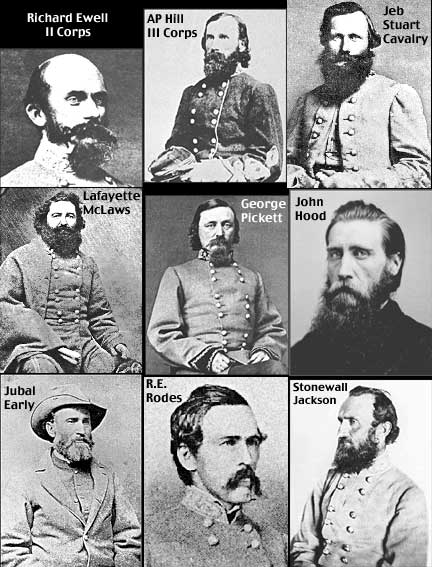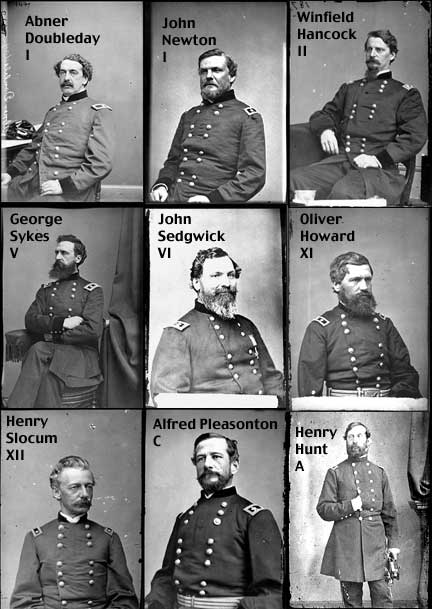Commanders
South

|
|
Stonewall was not present,
but he cast a long shadow.
|
|
Corps
|
Division
|
Brigade
|
|
I Corps
Longstreet
|
McLaws
Pickett
Hood
-
|
Kershaw, Barksdale, Semmes, Wofford, Cabell
Garnett, Kemper, Armistead, Dearing
Law, Robertson, Anderson, Benning, Henry
Walton
|
|
II Corps
Ewell
|
Early
Johnson
Rodes
-
|
Hays, Smith, Avery, Gordon, Jones
Steuart, Williams, Walker, Jones, Latimer
Daniels, Iverson, Doles, Ramseur, O'Neal, Carter
Brown
|
|
III Corps
A.P. Hill
|
Anderson
Heth
Pender
-
|
Wilcox, Wright, Mahone, Lang, Posey, Lane
Pettigrew, Brokenbrough, Archer, Davis, Garnett
Abner, Lane, Thomas, Scales, Poague
Walker
|
|
Cavalry
|
Stuart
|
Hampton, Robertson, Jones,
Fitz. Lee, Jenkins, W.H.F. Lee,
Beckham
Imboden
|
Confederate Commanders
Italics indicates an artillery command.
North

|
|
The Union Corps
Commanders
|
The I Corps had three commanders in the course of the battle. I
suspect the photographers started taking pictures of generals only
after Gettysburg. General Reynolds, the I Corps general who died
early in the fighting is not among the Library of Congress portraits.
Daniel Sickles of the III Corps is shown on the lead page. He was
wounded on July 2nd. His successor, General Birney, is also
unavailable. Pleasonton led the cavalry. Hunt was on Meade's staff,
not in line command, but was in charge of artillery.
|
Corps
|
Division
|
Brigade
|
|
I Corps
Reynolds
Doubleday
Newton
|
Wadsworth
Robinson
Rowley
-
|
Meredith, Cutler
Paul, Baxter
Biddle, Stone, Stannard
Wainwright
|
|
II Corps
Hancock
Gibbon
|
Caldwell
Gibbon
Hays
-
|
Cross, Zook
Harrow, Webb, Hall
Carroll, Smyth, Willard
Hazard
|
|
III Corps
Sickles
Birney
|
Birney
Humphreys
-
|
Grahm, Ward, Trobriand
Carr, Brewster, Burling
Randolph
|
|
V Corps
Sykes
|
Barnes
Ayres
Crawford
-
|
Tilton, Sweitzer, Vincent
Day, Burbank, Weed
McCandless, Fisher
Martin
|
|
VI Corps
Sedgwick
|
Wright
Howe
Newton
-
|
Torbert, Bartlett, Russell
L. Grant, Neill
Shaler, Eustis, Wheaton
Tompkins
|
|
XI Corp
(German Corps)
Howard
Schurz
|
Barlow
Steinwehr
Schurz
-
|
Von Gilsa, Ames
Coster, Smith
Schimmelfennig, Krzyzanowski
Osborn
|
|
XII Corps
Slocum
Williams
|
Williams
Geary
-
|
McDougall, Lockwood, Ruger
Candy, Cobham, Greene
Muhlenberg
|
|
Cavalry Corps
Pleasonton
|
Buford
D. Gregg
Kilpatrick
-
|
Gamble, Devin, Merritt
McIntosh, J.I. Gregg
Farnsworth, Custer
Robertson, Tidball
|
|
Artillery Reserve
|
Tyler
Robertson
|
Ransom, McGilvery, Taft,
Huntington, Fitzhugh
|
Union Commanders
Italics indicates an artillery command.
The Union had slightly more men, but a lot more Corps, Divisions
and Brigades. Union reinforcements tended to arrive as new regiments
or new brigades, rather than as soldiers to bring old units up to
strength. Thus, the veteran organizations become ever smaller as the
war progressed. Many of the maps on these pages show Confederate
divisions, but Union Corps. The maps are just too small to show all
19 Union infantry divisions clearly. Showing nine southern divisions
and seven northern corps offers better clarity.
During the winter of 1863 - 1864, the AoP was reorganized into
fewer but larger Corps. Many vetrans of the dissolved Corps that
vanished during the reorganization were displeased, but the resulting
army was easier to manage. Among the Corps dissolved were the I and
III Corps, effective fighting forces on the morning of July 1st 1863,
but mere shadows of themselves by July 4th.
The Union has 12 artillery brigades with its infantry, one with
each Corps, and five in an army level reserve. The Confederates also
had twelve brigades of artillery with their infantry, one with each
division, and another in reserve with each Corps.
Next: An
introduction to Civil War Tactics.
Or skip to A
brief summary of the first day.

